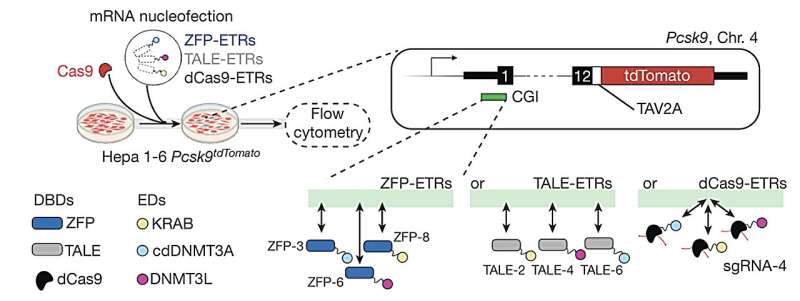This article has been reviewed according to Science X's editorial process and policies. Editors have highlighted the following attributes while ensuring the content's credibility:
fact-checked
peer-reviewed publication
trusted source
proofread
Silencing a gene could lower cholesterol

Durable repression of a gene that has a role in controlling cholesterol levels, achieved without permanent genome editing, has been demonstrated in a mouse study published in Nature this week.
The effects of targeted epigenetic silencing—in which gene function is changed without direct changes to the DNA sequence—are shown to last for nearly one year in mice and to lead to reductions in circulating cholesterol. The results demonstrate the potential of epigenetic silencing for the treatment of diseases.
Altering the expression of genes that are involved in illnesses holds promise for the treatment of human diseases. Genome editing approaches have shown some success, but there are concerns that breaking the DNA to introduce sequence changes may lead to unwanted mutations or unexpected off-target activity.
Epigenome editing is an attractive alternative, as it modifies the chemical groups that decorate the DNA without changing the genetic sequence, but lasting silencing of targeted genes has been challenging to achieve.
Angelo Lombardo and colleagues from Milan, Italy, describe an approach to silence the Pcsk9 gene, which produces a protein that promotes the degradation of protein receptors for low-density lipoproteins (a form of cholesterol), in mice.
The researchers screened for different DNA binding platforms that can recognize the targeted gene and found that zinc finger proteins provide the best performance. They then used lipid nanoparticles to deliver the epigenetic editing machinery to the bloodstream of the mice, where the lipid nanoparticles then circulated to the liver.
A single administration of the epigenetic modifiers achieved efficient and durable silencing of the Pcsk9 gene in mice, almost halving circulating levels of the PCSK9 protein, for up to 330 days (when the experiment ended). Further improvements to their approach were shown to reduce PCSK9 levels to those achievable using conventional gene editing (up to 75%).
The authors note that these findings are a proof of principle, which warrant more investigations. They suggest that, with further evaluation, their platform may lay the foundation for the development of therapeutics that use epigenetic silencing.
More information: Martino Alfredo Cappelluti et al, Durable and efficient gene silencing in vivo by hit-and-run epigenome editing, Nature (2024). DOI: 10.1038/s41586-024-07087-8
Journal information: Nature
Provided by Nature Publishing Group





















